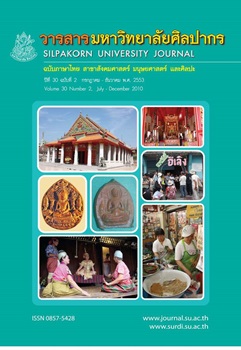พระพิมพ์ในประเทศไทยและเอเชียอาคเนย์ : ประติมานวิทยา หน้าที่ใช้สอย และบริบททางพิธีกรรม Buddhist Sealings in Thailand and Southeast Asia: Iconography, Function and Ritual Contexts
Main Article Content
Abstract
บทคัดย่อ
ดร.สกิลลิ่งได้สรุปถึงการวิจัยเรื่องพระพิมพ์ของท่านที่ทำต่อเนื่องกันมาหลายชิ้นไว้ว่า บ่อยครั้งที่มีการค้นพบพระพิมพ์ดินดิบและดินเผาไฟอ่อนที่ทำจากตราประทับหรือแม่พิมพ์ ตลอดทั่วทั้งเอเชียอาคเนย์ ส่วนใหญ่พบอยู่ตามสถูปเจดีย์ แตที่พบอยู่ตามถ้ำต่างๆ ก็มีเช่นกันโดยเฉพาะอย่างยิ่งมีการพบในประเทศไทยเป็นจำนวนมาก ซึ่งล้วนสร้างขึ้นมาตั้งแต่ราวพุทธศตวรรษที่ 12 เรื่อยมาจนถึงสมัยอยุธยาและรัตนโกสินทร์ พระพิมพ์เหล่านี้มีหลากหลายรูปแบบนับตั้งแต่พระพิมพ์ที่มีภาพพระพุทธเจ้า พระโพธิสัตว์เดี่ยวๆ ไปจนถึงพระพิมพ์แบบที่มีภาพซับซ้อนขึ้น พระพิมพ์บางแบบก็มีลักษณะร่วมกันที่แสดงถึง ‘โลกพุทธศาสนา’ อันยิ่งใหญ่ พระพิมพ์บางแบบก็แสดงถึงลักษณะท้องถิ่น หรือบ้างก็แสดงถึงลักษณะเฉพาะแหล่งที่พบ พระพิมพ์บางแบบก็มีอักษรประกอบ ทั้งในคติพุทธศาสนา เช่น พระคาถา เยธมฺมา หรือนามของผู้อุทิศ
จากความจริงที่ว่าพระพิมพ์เหล่านี้มีหลากหลายพิมพ์ ทั้งยังสร้างขึ้นต่อเนื่องมาเป็นระเวลายาวนาน ในหลายแหล่งหลายพื้นที่สิ่งที่ได้นำเราไปสู่ข้อสรุปว่า การผลิตพระพิมพ์นับเป็นลักษณะเด่นอันสำคัญในวัฒนธรรมพุทธศาสนาของภูมิภาคนี้ก็ว่าได้ และโดยการใช้เอกสารสันสกฤต เอกสารธิเบต และเอกสารพม่าในยุคพุกาม บทความชิ้นนี้ของดร.สกิลลิ่ง จึงถือได้ว่าเป็นการศึกษาต่อยอด โดยการเสนอทฤษฎีใหม่สำหรับพระพิมพ์ที่มีต้นกำเนิดมาจากอินเดียจากการศึกษาจารึกที่ระบุนามผู้อุปถัมภ์จากไทยและพม่าทำให้เราได้ข้อมูลเกี่ยวกับผู้สร้างหรือผู้อุทิศ จุดมุ่งหมายและสถานภาพทางสังคม จารึกที่ปรากฏด้านหลังของพระพิมพ์ล้วนแสดงถึงความต้องการให้ได้รับผลบุญ การหลุดพ้นและความหวังที่จะก้าวไปสู่พระนิพพานเช่นพระพุทธองค์ (โดยเฉพาะอย่างยิ่งในส่วนภาคผนวกของบทความชิ้นนี้น่าสนใจมาก เพราะได้ให้คำแปลล่าสุดของคัมภีร์สั้นๆ สำหรับพิธีกรรมที่ใช้ในการสร้างพระพิมพ์ ซึ่งเขียนขึ้นโดยท่านอติศะ (Atiśa) ภิกษุชาวเบงกอล ผู้เคยมาศึกษาพุทธศาสนายังเอเชียอาคเนย์ ภายหลังท่านได้กลายเป็นบุคคลสำคัญทางพุทธศาสนาในธิเบต)
คำสำคัญ: 1. พระพิมพ์ในประเทศไทย. 2. พระพิมพ์ในเอเชียอาคเนย์.
Abstract
by Peter Skilling Baked and unbaked clay artifacts produced from seals or molds, known as ‘sealings’ or ‘votivetablets’, are found throughout Southeast Asia, most frequently in proximity to stūpas, but also in caves.They are especially numerous in Thailand, where they were produced from about the seventh century upto the Ayutthaya and even Bangkok periods. They bear a rich variety of designs, from single Buddhas orBodhisattavas to complex scenes. Some designs are common to the ‘greater Buddhist world’, others to theregion, and others to specific sites. Some of the tablets are inscribed, either with Buddhist texts – about allthe ubiquitous ye dharmā versa – or donative inscriptions.The fact that so many sealings were produced – in such variety, over such a long period, and at somany sites – leads us to conclude that the practice had considerable significance in the Buddhist cultures ofthe region. Using Sanskrit, Tibetan, and Pagan-period Burmese evidence, the paper proposes a new theoryfor the original Indic term for the sealings. Donative inscriptions from Siam and Burma are examined for theinformation they give about the donors, their motives, and their social positions. The inscriptions show thatthe donors produced the sealings in order to gain merit, liberation, and Buddhahood.An appendix gives a new translation of a short ritual text on the production of sealings, composedby the celebrated Bengali master Atiśa, who studied in Southeast Asia and later went on to become a keyfigure in the Buddhism of Tibet.
Keywords: 1. Buddhist sealings in Thailand. 2. Buddhist sealings in Southeast Asia.


